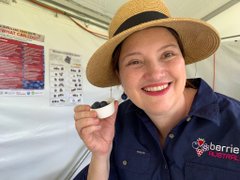Be on the look out for Brown Marmorated Stink Bugs
There is a significantly increased concern over Brown marmorated stink bug (BMSB) entering Australia. Growers across the horticulture sector need to stay super vigilant with seasonal biosecurity measures and report anything unusual. The BMSB season or high-risk period for this pest is typically from the 1st of September to the 30th of April.
These concerns have resulted in all states and territories conducting enhanced surveillance activities at detection sites and surrounding areas, as well as high-risk facilities. This increased surveillance includes trapping, visual monitoring and in some cases pesticide applications.
What is BMSB and why is it a concern?
BMSB is an exotic pest found overseas in parts of Asia, North America and Europe. It poses a significant threat to Australian agriculture due to its broad host range and damaging effects on vegetable and fruit crops and ornamental trees. Known to feed on over 300 plant species, BMSB causes significant damage to plant tissues through feeding activities.
While BMSB detections at Australia’s borders are not uncommon, strict biosecurity measures help to prevent its entry and spread. The pest is a renowned seasonal hitchhiker associated with the arrival of imported goods and cargo, especially in containers or shipments of vehicles or agricultural machinery. Increased movement of containers and global shipping of international goods and online orders heightens this risk during peak seasons.

Adult Brown Marmorated Stink Bug. Photo David R. Lance, USDA APHIS PPQ, Bugwood.org
What to look for
Adults: Mottled/ speckled brown insect with a shield-shaped appearance, measuring between 12—17mm long, with blunt heads and antennae marked with at least one white band
Nymphs: Young insect stages are orange and black when first hatched, ranging in size from 3—12mm long and becoming similar colour to adults
Eggs: Laid in clusters on the underside of leaves, are cream to yellow-orange in colour, measuring 1.6mm long

Nymph showing characteristic white bands on legs, antenna and along edge of body. Photo Gary Bernon, USDA APHIS, Bugwood.org

Eggs and nymphs. Photo David R. Lance, USDA APHIS PPQ, Bugwood.org
What should I do?
All horticulture sectors should exercise greater caution during the present BMSB season, stay informed, monitor crops and facilities regularly, and take extra care with imported goods during this higher-risk period.
- Familiarise yourself with the appearance of BMSB across its life stages
- Inspect growing areas, packing sheds, imported equipment or packaging, pallets and bins frequently
- Maintain good hygiene and quarantine practices for the arrival of any goods or materials on your property
If you think you have seen BMSB in your crop or on your property, please contact the Exotic Plant Pest Hotline on 1800 084 881 or the Department of Agriculture, Fisheries and Forestry via this form: Report a pest or disease concern
Are there treatment options?
The Australian Government is considering potential pesticide options to safeguard against this pest. However, currently there are no registered chemical products for the management of BMSB in berries in Australia.
Growers already managing endemic stink bug species will be familiar with some control options that could potentially be useful for BMSB management. However, these are generally more broad-spectrum pesticides and IPM programs, WHPs and MRLs must be considered before use.
Internationally, parasitoid wasps and kaolin clay sprays have seen success in managing BMSB in situations where conventional pesticides cannot be used e.g. organic production.
Learn more
For further information on BMSB and the risk it poses to Australian agriculture, you can download Plant Health Australia’s factsheet by visiting: BMSB Fact Sheet




